James Lockhart Perry's Blog, page 17
January 1, 2014
Bran
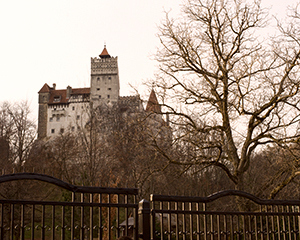 Centuries before Bram Stoker found inspiration for his novel Dracula, best-selling stories were circulating in Europe about the fifteenth-century Vlad III, Prince of Wallachia, better known as Vlad Țepeș, or Vlad the Impaler. Vlad’s favorite punishment for invading Turks, recalcitrant Boyars, and highway robbers alike (around 100,000 total by his own estimate) was impalement through the stomach on a stake driven into the earth.
Centuries before Bram Stoker found inspiration for his novel Dracula, best-selling stories were circulating in Europe about the fifteenth-century Vlad III, Prince of Wallachia, better known as Vlad Țepeș, or Vlad the Impaler. Vlad’s favorite punishment for invading Turks, recalcitrant Boyars, and highway robbers alike (around 100,000 total by his own estimate) was impalement through the stomach on a stake driven into the earth.
It was said that Mehmet II, the Ottoman Sultan and Vlad’s arch-enemy, was so sickened on one invasion by the sight of 20,000 of his advance troops impaled on the banks of the Danube, that he turned around and went home. Not that Mehmet was much of a humanist either–he just preferred more pleasant fates like beheading (for his enemies) and strangulation or testicle-crushing (for his relatives).
Incidentally, the Dragon Society was formed in the fifteenth century to defend Christianity against the Moslem Turkish horde. Vlad’s father, Vlad I, took the sobriquet Dracul to signify his membership, so Vlad added Dracula to his own name. Three castles in the Romanian back-country are as associated with Vlad as the tourist trade will allow. This one at Bran has the most tenuous connection (he might have stayed here one night), but it fits better with Stoker’s gruesome hero than the fighting castles Vlad actually inhabited.
Ordinary Romanians remember Vlad as a freedom-fighter and despise the Dracula association (along with the thousands of ghoulish visitors it brings to the country every Halloween), but can’t resist taking all the tourist gold. They like to redirect the more gruesome imagination to the story of the true Dracula, one Elizabeth of Bathori, a wildly promiscuous Hungarian Princess of Slovakian residence, who discovered the secret of eternal youth to be found in bathing in a mixture of milk and virgin blood. After murdering 650 local virgins, the Princess was walled up in her castle and allowed to wither away.
Or so the stories all go…
Filed under: Travels Tagged: Romania, Travel

December 29, 2013
Orient Express
 The original Orient Express started running in 1881 from Paris to Istanbul via the northern, Romanian route, or Paris-München-Wien-Budapest-București-Istanbul. After World War I, the southern route, via Belgrade and Sofia instead of București, became popular. Today, either service is long gone, but you can retrace the route with individual sleeper trains booked along the way.
The original Orient Express started running in 1881 from Paris to Istanbul via the northern, Romanian route, or Paris-München-Wien-Budapest-București-Istanbul. After World War I, the southern route, via Belgrade and Sofia instead of București, became popular. Today, either service is long gone, but you can retrace the route with individual sleeper trains booked along the way.
We are currently taking still another variant of the original route, starting in Bruxelles and changing in Koln for Wien. With a few days off in Romania to go searching for Vlad the Impaler, this means six days of travel with four nights on a train. Each country manages its own leg, and the service runs from Spartan cleanliness (Germany-Austria) to decrepit elegance (Hungary-Romania). Our favorite has been the Romanian train, the Ister, even though you need to bring your own toilet paper and food, in case they forget to hitch up the saloon car.
Don’t even think about taking this journey without consulting The Man in Seat 61. There are simply too many variables and mishaps awaiting you, and he does a beautiful job of covering them all.
Filed under: Travels Tagged: Austria, Belgium, Bulgaria, Germany, Hungary, Romania, Travel, Turkey

Budapest
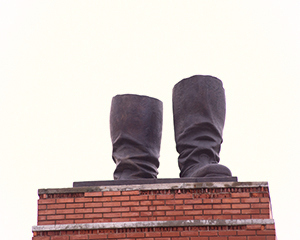 After the Hungarian Revolution of 1989, when citizens were ripping down Soviet memorials all over the country, one bright official had the idea of creating a tongue-in-cheek memorial in the countryside outside of town to hold the deposed statuary. The open-air Memento Park opened its doors on the second anniversary of the liberation and now houses one of the more bizarre (and less subtle) collections of political art ever assembled.
After the Hungarian Revolution of 1989, when citizens were ripping down Soviet memorials all over the country, one bright official had the idea of creating a tongue-in-cheek memorial in the countryside outside of town to hold the deposed statuary. The open-air Memento Park opened its doors on the second anniversary of the liberation and now houses one of the more bizarre (and less subtle) collections of political art ever assembled.
Unfortunately, the biggest statue of them all–of Comrade Stalin–had already been broken up into tiny pieces, leaving just his boots for the exhibition. Still, it seems appropriate that the boots that trod roughshod all over Eastern Europe should commemorate the dead dictator. He will not be missed around these parts.
Filed under: Travels Tagged: Hungary, Travel

December 18, 2013
Wind River Canyon
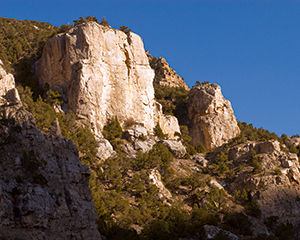 The first time Lockhart and his favorite West Virginia coal miner traveled this 2,500-foot-deep, 20-mile canyon, they got into a heated argument over whether they were driving up or downhill (“Not even a damn Yankee can talk a river into flowing uphill!”). It sounds ridiculous, but subsequently, they found out that everyone suffers the same loss of vertical direction in this vast, narrow, and thoroughly intimidating slot through the Owl Creek Mountains of central Wyoming.
The first time Lockhart and his favorite West Virginia coal miner traveled this 2,500-foot-deep, 20-mile canyon, they got into a heated argument over whether they were driving up or downhill (“Not even a damn Yankee can talk a river into flowing uphill!”). It sounds ridiculous, but subsequently, they found out that everyone suffers the same loss of vertical direction in this vast, narrow, and thoroughly intimidating slot through the Owl Creek Mountains of central Wyoming.
The river gathers at the Boysen Reservoir in the south and travels northward out of the Wind River Indian Reservation, home of the Eastern Shoshone and Northern Arapahoe tribes. Just before Thermopolis, it exits the canyon into the Wedding of the Waters, where it becomes the Bighorn River. The Reservation was established in 1868 by the Fort Bridger Treaty, negotiated by the famous diplomat Chief Washakie of the Eastern Shoshones with, among others, William Tecumseh Sherman of Atlanta-burning fame. Thanks in large part to topography and to Washakie’s friendships with key whites like the Mountain Man Jim Bridger, the area tribes more or less sat out the violent 19th-century wars to the north.
The grateful whites rewarded Washakie with a military funeral and the naming of a fort and town, a county, another town, a university dining hall, a transport ship, and a tugboat after him.
Filed under: Travels Tagged: Travel, Wyoming

December 17, 2013
Flers–Courcelette
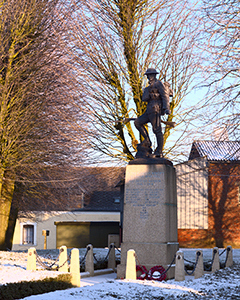 The statue in the center of this tiny, anonymous village in northern France is remarkable for three reasons:
The statue in the center of this tiny, anonymous village in northern France is remarkable for three reasons:
First, it commemorates a foreigner–the British Tommy, or infantry foot-soldier, who fought and died by the thousands in this section of the 1916 Somme Offensive in World War I. The French don’t erect a lot of statues to foreigners.
Second, in a war famous for its utter indifference to the fate and heroics of the common soldier, this village forewent the usual memorial to some general who had spent the war comfortably ensconced miles from the front in favor of this simple reminder of exactly who bore the brunt of the fighting.
But the third and most surprising reason for wondering about this bronze Tommy is that he stands where the first armored tank in history was offloaded on September 15, 1916, and sent lumbering on its caterpillar tracks to the nearby front. Not a sign or mention anywhere in the village of the then-top-secret British invention that, along with the airplane, defined warfare in the twentieth century.
The British, led by one of the least talented Generals in history, Sir Douglas Haig, had no real clue about the offensive potential of their weapon and envisioned it as a sort of land battleship for use as infantry support. After the initial surprise, the Germans quickly neutralized the nine (out of forty-nine) vehicles that didn’t break down on their own along the way. The battle netted a gain of two kilometers at a cost of 29,376 lives, but as usual on the Western Front in World War I, no Generals were fired.
In a perverse classification worthy of Freud, the British divided their early tank designs into Male (carrying large cannons) and Female (nothing but machine guns). The earliest design was called the Little Willie, but it was the Mother version and her descendants that eventually conquered the world.
Filed under: Travels Tagged: France, Travel

December 16, 2013
Galveston
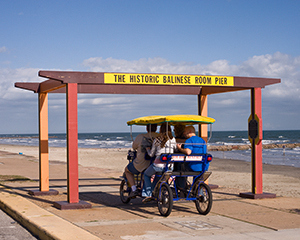 The Galveston seawall was always a little raunchy, but Lockhart and wife were still sorry to see the Balinese Room and its pier vanish in Hurricane Ike on the evening of September 13, 2008. We used to walk from the nearby pier hotel (also wrecked) and guzzle on the Margaritas, supposedly invented in the bar here for the visiting Peggy Lee (and named after her).
The Galveston seawall was always a little raunchy, but Lockhart and wife were still sorry to see the Balinese Room and its pier vanish in Hurricane Ike on the evening of September 13, 2008. We used to walk from the nearby pier hotel (also wrecked) and guzzle on the Margaritas, supposedly invented in the bar here for the visiting Peggy Lee (and named after her).
Opened in 1942 by the mobbed-up, bootlegging Maceo brothers Sam and Rosario, the club featured Sicilian food, great drinks, illegal gambling, and acts as varied and famous as Frank Sinatra, Burns and Allen, and the Marx Brothers. Lockhart’s gorgeous jitterbugging mother-in-law Louvelle never missed a chance to come strut her stuff on the big-band dance floor.
The well-connected club gave rise to one of the great excuses of all time, when the Sheriff of Galveston County explained to a committee of the Texas Legislature that he couldn’t shut down the notorious venue because he wasn’t a member and therefore couldn’t get in. Sixty-four consecutive nights of raids by the Texas Rangers failed to find a single incriminating chip, but in 1957, when the authorities finally figured out the scam, they tossed chips, machines, and tables over the rails into the surf. And with them, washed away one of the more colorful pieces of Texan history.
Galveston remains a favorite spot of ours for seafood and drinks, but it will never be the same. No doubt, visitors said the same thing after the 1900 hurricane that caused even greater havoc. Yet the locals just seem to pick up and move onward into the future. Resolute doesn’t do them justice.
Filed under: Travels Tagged: Texas, Travel

Houma
 Lockhart’s nominee for Best Guide Ever is Jimmy Miller, son of the original and justifiably famous Alligator Annie, who whiled away an entire day exploring the cricks and bayous of southeastern Louisiana with us. We met him early in the morning at the Bayou Delight Restaurant on Bayou Black Drive and took off in his swamp boat for places we could never find again in a million years.
Lockhart’s nominee for Best Guide Ever is Jimmy Miller, son of the original and justifiably famous Alligator Annie, who whiled away an entire day exploring the cricks and bayous of southeastern Louisiana with us. We met him early in the morning at the Bayou Delight Restaurant on Bayou Black Drive and took off in his swamp boat for places we could never find again in a million years.
It doesn’t hurt when you show up between Christmas and New Year’s, when the already relaxed locals haven’t seen an outsider in weeks. Lockhart’s wife found Jimmy by asking around the shops and cafés in town in her best Texas drawl. He wasn’t working that week, but, gentleman that he is, showed up anyway. The result was some of the best–and most intricate–photos we’ve ever taken.
Lockhart has only suffered through two tours in his life (the other was to Petra in Jordan, another place where it pays to bring along someone who knows where they’re going). Yet, even if he was less snooty and obstreperous on the subject, he’s pretty sure Jimmy would own the title.
If you’re headed for Houma, here is Jimmy’s website, such as it is.
Filed under: Travels Tagged: Louisiana, Travel

Dachau to Berchtesgaden
The shortest route between heaven and hell is exactly 181km long and less than two hours by car. At one end, Konzentrationslager Dachau, the mother of all Nazi concentration camps and chief training facility for some of the most gruesome atrocities in history. At the other end, the gorgeous heights of Berchtesgaden, where the thugs of the Nazi leadership rested and recuperated in between bouts of worldwide mayhem.
When juxtaposed like this, each place is as ghastly in its way as the other. And you can visit one in the morning and reach the other before nightfall, even in winter. Lockhart and wife made the trip and ended up stuck in a snowstorm at the Intercontinental Hotel, built on the ruins of Hermann Göring’s palatial residence just down from the Kehlsteinhaus, or Eagle’s Nest. Can’t say we slept all that well–far too many far too hideous ghosts to go with all that grandeur.
Crime might not pay forever, but in this case, it took twelve long years and unimaginable suffering for the check to bounce.
Filed under: Travels Tagged: Germany, Travel

Berchtesgaden
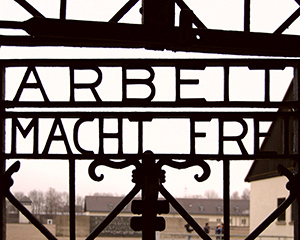 The shortest route between heaven and hell is exactly 181km long and less than two hours by car. At one end, Konzentrationslager Dachau, the mother of all Nazi concentration camps and chief training facility for some of the most gruesome atrocities in history. At the other end, the gorgeous heights of Berchtesgaden, where the thugs of the Nazi leadership rested and recuperated in between bouts of worldwide mayhem.
The shortest route between heaven and hell is exactly 181km long and less than two hours by car. At one end, Konzentrationslager Dachau, the mother of all Nazi concentration camps and chief training facility for some of the most gruesome atrocities in history. At the other end, the gorgeous heights of Berchtesgaden, where the thugs of the Nazi leadership rested and recuperated in between bouts of worldwide mayhem.
When juxtaposed like this, each place is as ghastly in its way as the other. And you can visit one in the morning and reach the other before nightfall, even in winter. Lockhart and wife made the trip and ended up stuck in a snowstorm at the Intercontinental Hotel, built on the ruins of Hermann Göring’s palatial residence just down from the Kehlsteinhaus, or Eagle’s Nest. Can’t say we slept all that well–far too many far too hideous ghosts to go with all that grandeur.
Crime might not pay forever, but in this case, it took twelve long years and unimaginable suffering for the check to bounce.
Filed under: Travels Tagged: Germany, Travel

Saint-Loup de Varennes
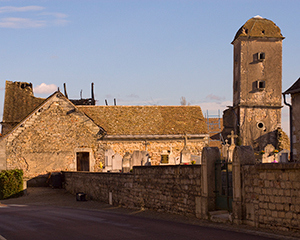 A massive concrete sign outside this village just north of Chalon-sur-Saone in Bourgogne announces that one Nicéphore Niépce invented photography here in 1822. For once, one of these weird historical claims appears to be accurate–as long as you define photography as the permanent imprinting of images on light-sensitive materials using chemicals.
A massive concrete sign outside this village just north of Chalon-sur-Saone in Bourgogne announces that one Nicéphore Niépce invented photography here in 1822. For once, one of these weird historical claims appears to be accurate–as long as you define photography as the permanent imprinting of images on light-sensitive materials using chemicals.
The Niépce family was famously ill-tempered and eccentric–the oldest brother Claude went mad and died in London while marketing another family invention, the fuel-injected internal combustion engine (seriously–they named it the Pyréolophore). In the process, he managed to squander the family fortune so thoroughly that the father of photography himself nearly ended up an unmarked municipal grave. Judging by the current state of the village in this photo, no one got rich off all the experimentation, other than a Niépce partner, Louis-Jacques-Mandé Daguerre, who stole most of the credit with his Daguerreotype.
As long as we’re cluttering up your mind with useless information, Nicéphore was actually baptized Joseph, but changed his name to honor Saint Nicephorus. The latter led the 9th-century Iconodules in their successful fight to prevent the Byzantine Iconoclasts from outlawing the veneration of religious images.
Imagine a world without religious art or photography–except, thanks to these gents, you don’t have to.
Filed under: Travels Tagged: France, Travel




